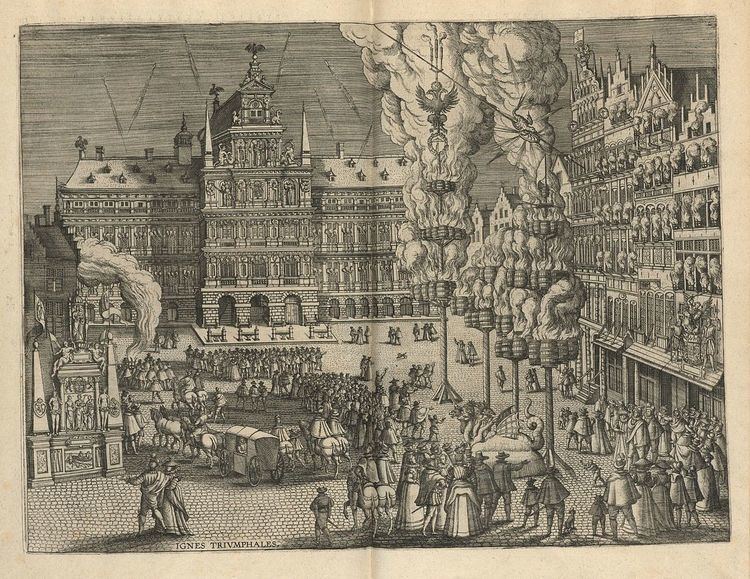 | ||
Festival books (Dutch: feestboeken, Spanish: libros de festivos) are books, often illustrated, that commemorate a notable event such as a royal entry, coronation or wedding. Funerals were also commemorated in similar fashion. The genre thrived in Renaissance and early modern Europe, where rulers utilized the form to both document and embellish displays of wealth and power.
Contents
Description
Large numbers were produced, often surviving in very few copies; the largest collection, in the British Library, has over 2000 examples. Originally manuscripts, often illustrated, compiled for prince or city, with the arrival of print they were frequently published, varying in form from short pamphlets describing the order of events, and perhaps recording speeches, to lavish books illustrated with woodcuts or engravings showing the various tableaux, often including a fold-out panorama of the procession, curling to and fro across the page. The pamphlets were ephemera; a printed description of two leaves describing the entry of Ferdinand II of Aragon into Valladolid, 1513, survives in a single copy (at Harvard) because it was bound with another text. A lost description of the ceremonious reception given by Louis XII to Ferdinand at Savona (June 1507) is only known from a purchase receipt of Ferdinand Columbus.
These livrets are not always to be trusted as literal records; some were compiled beforehand from the plans, and others after the event from fading memories. The authors or artists engaged in producing the books had by no means always seen the entry themselves. Roy Strong finds that they are "an idealization of an event, often quite distant from its reality as experienced by the average onlooker. One of the objects of such publications was to reinforce by means of word and image the central ideas that motivated those who conceived the programme." Philip II of Spain's ceremonial entry into Antwerp in 1549 was all but called off because of torrential rain, but the book shows it as it should have been. Thomas Dekker, the playwright and author of the book on The Magnificent Entertainment for James I of England is refreshingly frank:
Reader, you must understand, that a regard, being had that his Majestie should not be wearied with teadious speeches; A great part of those which are in this Booke set downe, were left unspoken; So that thou doest here receive them as they should have been delivered, not as they were.The Holy Roman Emperor, Maximilian I, went a step further, creating enormous virtual triumphs that existed solely in the form of print. The Triumphs of Maximilian (begun in 1512 and unfinished at Maximilian's death in 1519) contains over 130 large woodcuts by Albrecht Dürer and other artists, showing a huge procession (still in open country) culminating in the Emperor himself, mounted on a huge car. The Triumphal Arch (1515), the largest print ever made, at 3.57 x 2.95 metres when the 192 sheets are assembled, was produced in an edition of seven hundred copies for distribution to friendly cities and princes. It was intended to be hand-coloured and then pasted to a wall. Traditional tableau themes, including a large genealogy, and many figures of Virtues, are complemented by scenes of Maximilian's life and military victories. Maximilian was wary of entries in person, having been locked up by his loyal subjects in Bruges in 1488 for eleven weeks, until he could pay the bills from his stay.
An early meeting between the festival book with travel literature is the account of the visit in 1530 of the future Ferdinand I, Holy Roman Emperor, then King of Hungary and Bohemia, to Constantinople.
